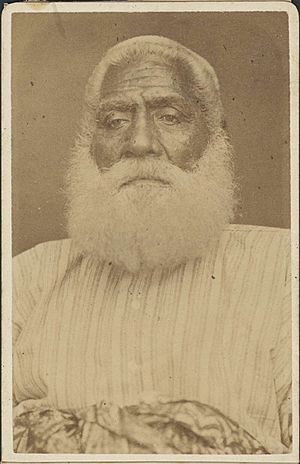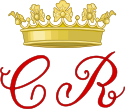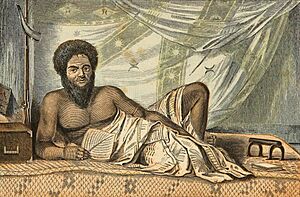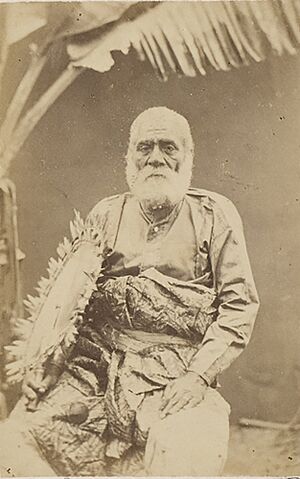Seru Epenisa Cakobau facts for kids
Quick facts for kids Ratu Seru Epenisa Cakobau |
|
|---|---|
| King of Fiji 6th Vunivalu of Bau King of Bau |
|
 |
|
| King of Fiji | |
| Reign | 5 June 1871 – 10 October 1874 |
| Successor | Victoria |
| Born | circa 1815 Natauloa, Nairai, Lomaiviti, growing up on Vanuaso, Gau, Lomaiviti before returning to Bau. |
| Died | 1 February 1883 (aged 67–68) |
| Spouse | Adi Litia Samanunu Adi Salote Qalirea Kaunilotuna |
| Issue | Children by Adi Litia Samanunu: Adi Arieta Koila Ratu Epeli Nailatikau I Adi Asenaca Kakua Vuikaba Ratu Timoci Tavanavanua Ratu Josefa Celua Children by Adi Salote Qalirea Kaunilotuna: Ratu Sukuna Vana Ratu Viliame Bulu Adi Lusiana Qolikoro |
| Father | Tanoa Visawaqa |
| Mother | Adi Savusavu |
| Religion | Methodist |
| Signature |  |
Ratu Seru Epenisa Cakobau (born around 1815 – died February 1, 1883) was a powerful Fijian chief and leader. He managed to bring together many of Fiji's different tribes under his rule. This led to the creation of a united Fijian kingdom. He was born on Nairai Island but spent his younger years on Gau Island. Later, he returned to Bau to help his father, Ratu Tanoa Visawaqa, regain his power. Seru was given the name "Cakobau," which means "destroyer of Bau." This name came from his grandfather's efforts to take control of Bau. Seru became the 6th "Vunivalu," or powerful chief, of Bau.
Contents
Early Life and Family
Seru Cakobau was born on Nairai Island in Lomaiviti. His father was Ratu Tanoa Visawaqa, and his mother was Adi Savusavu.
For nearly a hundred years, there were many power struggles between the Vunivalu (the main chief) and the Roko Tui Bau (a sacred chief). These struggles led to the death of Seru's uncle, the Vunivalu of Bau. After this, Seru's father, Tanoa, became the Vunivalu. However, Tanoa was sent away from Bau in 1832 after he killed another chief.
Seru Cakobau married two sisters, Litia Samanunu and Salote Qalirea Kaunilotuna. Both were daughters of the Roko Tui Bau.
In 1844, a woman named Mary Wallis met him and described him. She said he was tall and good-looking. He seemed to know how important he was and had a dignified manner. He wore a lot of hair on his head and many yards of native cloth around his body.
Seru was first called Cikinovu, meaning "Centipede." This was because he moved quietly but struck painfully. Later, he was called Cakobau, meaning "destroyer of Bau." This was because he changed what Bau used to be. But Seru also built a new, stronger Bau. After he became a Christian, he added the name Epenisa.
Becoming a Powerful Leader
On December 8, 1852, Cakobau took over as the Vunivalu of Bau. This made him the most important chief in the Bau area.
A missionary named James Calvert helped Cakobau become a Christian. This was an important change in his life.
Cakobau believed that Bau had power over all of Fiji. He declared himself the King of Fiji. However, other chiefs did not agree with him. They saw him as just the "first among equals," meaning he was important but not their ruler. Because of this, Cakobau fought many wars for almost 19 years. He wanted to unite all the islands under his rule.
The last major fight against Cakobau's rule happened at the Battle of Kaba. Cakobau won this battle with help from the King of Tonga. After the battle, because he was now a Christian, he chose to forgive all the people he had captured.
In 1865, a group called the Confederacy of Independent Kingdoms of Viti was formed. Cakobau was its leader. But two years later, this group split up. Cakobau then became the King of Bau.
With support from foreign settlers, he finally succeeded in creating a united Fijian kingdom in 1871. He made Levuka the capital city. He decided to set up a government where a king ruled with a constitution. The first meeting of the new government happened in November 1871. Most of the people in the government were foreigners.
Cakobau gave his special war club to Queen Victoria on October 10, 1874. This was when Fiji officially became part of the British Empire. Later, in 1932, King George V gave Cakobau's war club back to Fiji. It is now used as a special ceremonial staff in Fiji's government meetings.
Giving Up Power
The United States government had recognized Cakobau as the King of a united Fiji. But this actually caused problems for him later. The American government blamed him for a fire that happened in 1849 at the home of the American Consul. They demanded $44,000 in payment. Cakobau could not pay this large amount of money. He was worried that the Americans might invade Fiji. Because of this, Cakobau decided to give control of the islands to the United Kingdom.
Cakobau remained an important chief in Fiji. He kept his title of Vunivalu of Bau. But he formally gave the highest chief title, Tui Viti (Paramount Chief of Fiji), to Queen Victoria. This title was held by British monarchs until 2012. Cakobau lived a quiet life after this until he passed away on February 1, 1883.
His Lasting Impact
Many important leaders in Fiji today are direct descendants of Cakobau. For example, his great-grandson, Ratu Sir George Cakobau, was Fiji's first Governor-General from 1973 to 1983. Another descendant, Ratu Sir Kamisese Mara, was Fiji's first Prime Minister and later its second President.
Ratu Epeli Nailatikau, who became President of Fiji in 2009, is also a descendant. He is a grandson of Cakobau's granddaughter. Many other political figures in Fiji also trace their family lines back to Cakobau. This shows how important his legacy is in Fiji's history.
See also
- Fiji during the time of Cakobau
- First Fiji Expedition
- Second Fiji Expedition





